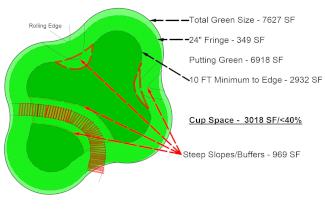Featured Golf News
How Much Cup Space Does a Green Have?
We have seen that, for maintenance reasons, all greens need from 14 to 21 cupping areas, usually about an 8-foot circle (50 square feet) to allow the four "busiest" feet around any cup location to heal. The last 3 to 5 feet around the cup eventually see most golfers that play (unless they pick up somewhere along the way) and, along with tees, see the most turf wear of any golf course area, while they need to be in the best condition for good play.

The solution is to move the cup around daily to areas that allow for cups. This, as we have previously discussed, is usually on areas with contours of less than 3 percent, although it varies with green speed.
Many wonder just how much of any green is typically used for cups. The answers are: 1) It varies, and 2) not as much as you might think. Look at this illustration for the reasons why.
As can be seen, if you build a shiny new USGA green of over 7,600 square feet, you can cup about 57 percent of that - if fully flat - by the time you subtract the fringe and 10-foot buffer where it is too close to the edge to set a pin. If the green has any internal contour, that number is reduced further.
If the contours occur mostly in the last 10 feet of the green, where you wouldn't cut a pin, the useable space is not reduced, but most ridges or valleys that we design into the green carry out a little further than that.
Where space is really lost is on steps or tiers within the green. As shown here, a 1-foot-high tier, which usually needs a maximum slope of 5-7 to 1 and may traverse the 50- to 70-foot width of the green, loses another 250 to 500 square feet. However:
• There would also be a small transition zone for the steeper slope of 1 to 2 feet top and bottom;
• No pin would be set less than 3- to 5-feet from top or bottom;
• The bottom pins may be set further from the base of any slope, since studies show it takes about 14 feet of rollout for a putt just cresting the hill to stop, and many courses might decide to make putts from the top tier "makeable" or at least allow them to stop within 2 to 3 feet of the cup.
Given all those factors, this 7,627-square-foot green allows cupping on just under 40 percent of its built surface, or about 3000 square feet, allowing about 60 cupping spots, which is still three to four times more that absolutely necessary.
Given the cost of new USGA-spec greens, you can see why many clubs instruct architects to build greens between 6,000 to 6,500 square feet to keep costs reasonable. That is above the minimum 4,000-square-foot greens possible if all cupping areas are flat, and allows the introduction of more contours.
The general rule of thumb is the more contour the green has, the more size it needs to provide adequate cup space, and each green design needs to be reviewed to assure adequate cup areas for best maintenance.
Jeffrey D. Brauer began his career as an apprentice in the Chicago area in 1977. His first project was Kemper Lakes, which shortly after hosted the 1989 PGA Championship. He formed GolfScapes in Arlington, Texas, in 1984. In the last 29 years he has designed and consulted on a wide spectrum of projects, ranging from partial renovations to international resorts. His recent work includes teaming with the design team of Pascuzzo and Pate on a remodel of the world-famous La Costa Resort & Spa in California, and renovations at Superior National Golf Course in Lutsen, Minn., and Mesquite Municipal Golf Course in Mesquite, Texas.
He has been a member of the American Society of Golf Course Architects since 1981, serving as President during its 50th Anniversary year in 1995-96. Jeff still studies the classic works - both old and new, and has played more than 75 of the best courses in the world.
Jeff gives many presentations and is a regular architecture columnist for many publications and websites, including Golf Course Industry and Cybergolf.com. He has also been a strong advocate for the "Tee it Forward" campaign and strives to make his courses fit the description of "fun to play every day."
Jeff's work has been spotlighted in most of the world's major golf magazines. Golf World ranked him as one of the top-20 golf course architects and Golf Inc. ranked him as the world's fourth-best value in golf architecture in 2010. Jeff's portfolio and reputation keep him at the forefront of desired designers for new courses, reconstruction and renovation projects. For more about Jeff, visit http://www.jeffreydbrauer.com/sites/courses/layout.asp?id=859&page=48451.
Story Options
 |
Print this Story |
